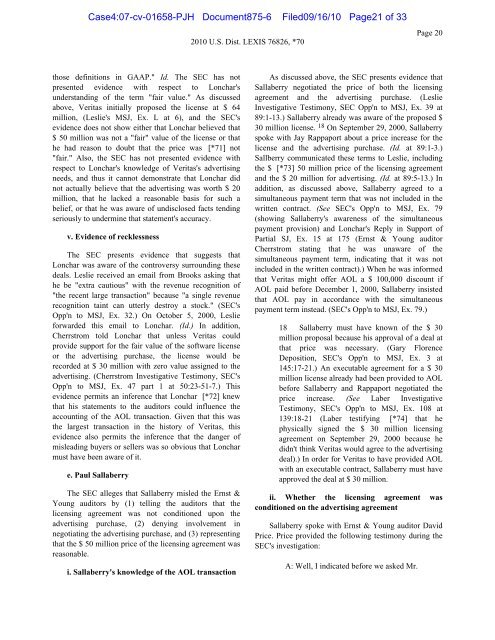exhibit 2 - SAP Lawsuit Portal
exhibit 2 - SAP Lawsuit Portal
exhibit 2 - SAP Lawsuit Portal
Create successful ePaper yourself
Turn your PDF publications into a flip-book with our unique Google optimized e-Paper software.
Case4:07-cv-01658-PJH Document875-6 Filed09/16/10 Page21 of 33<br />
those definitions in GAAP." Id. The SEC has not<br />
presented evidence with respect to Lonchar's<br />
understanding of the term "fair value." As discussed<br />
above, Veritas initially proposed the license at $ 64<br />
million, (Leslie's MSJ, Ex. L at 6), and the SEC's<br />
evidence does not show either that Lonchar believed that<br />
$ 50 million was not a "fair" value of the license or that<br />
he had reason to doubt that the price was [*71] not<br />
"fair." Also, the SEC has not presented evidence with<br />
respect to Lonchar's knowledge of Veritas's advertising<br />
needs, and thus it cannot demonstrate that Lonchar did<br />
not actually believe that the advertising was worth $ 20<br />
million, that he lacked a reasonable basis for such a<br />
belief, or that he was aware of undisclosed facts tending<br />
seriously to undermine that statement's accuracy.<br />
v. Evidence of recklessness<br />
The SEC presents evidence that suggests that<br />
Lonchar was aware of the controversy surrounding these<br />
deals. Leslie received an email from Brooks asking that<br />
he be "extra cautious" with the revenue recognition of<br />
"the recent large transaction" because "a single revenue<br />
recognition taint can utterly destroy a stock." (SEC's<br />
Opp'n to MSJ, Ex. 32.) On October 5, 2000, Leslie<br />
forwarded this email to Lonchar. (Id.) In addition,<br />
Cherrstrom told Lonchar that unless Veritas could<br />
provide support for the fair value of the software license<br />
or the advertising purchase, the license would be<br />
recorded at $ 30 million with zero value assigned to the<br />
advertising. (Cherrstrom Investigative Testimony, SEC's<br />
Opp'n to MSJ, Ex. 47 part 1 at 50:23-51-7.) This<br />
evidence permits an inference that Lonchar [*72] knew<br />
that his statements to the auditors could influence the<br />
accounting of the AOL transaction. Given that this was<br />
the largest transaction in the history of Veritas, this<br />
evidence also permits the inference that the danger of<br />
misleading buyers or sellers was so obvious that Lonchar<br />
must have been aware of it.<br />
e. Paul Sallaberry<br />
The SEC alleges that Sallaberry misled the Ernst &<br />
Young auditors by (1) telling the auditors that the<br />
licensing agreement was not conditioned upon the<br />
advertising purchase, (2) denying involvement in<br />
negotiating the advertising purchase, and (3) representing<br />
that the $ 50 million price of the licensing agreement was<br />
reasonable.<br />
i. Sallaberry's knowledge of the AOL transaction<br />
2010 U.S. Dist. LEXIS 76826, *70<br />
As discussed above, the SEC presents evidence that<br />
Sallaberry negotiated the price of both the licensing<br />
agreement and the advertising purchase. (Leslie<br />
Investigative Testimony, SEC Opp'n to MSJ, Ex. 39 at<br />
89:1-13.) Sallaberry already was aware of the proposed $<br />
30 million license. 18 On September 29, 2000, Sallaberry<br />
spoke with Jay Rappaport about a price increase for the<br />
license and the advertising purchase. (Id. at 89:1-3.)<br />
Sallberry communicated these terms to Leslie, including<br />
the $ [*73] 50 million price of the licensing agreement<br />
and the $ 20 million for advertising. (Id. at 89:5-13.) In<br />
addition, as discussed above, Sallaberry agreed to a<br />
simultaneous payment term that was not included in the<br />
written contract. (See SEC's Opp'n to MSJ, Ex. 79<br />
(showing Sallaberry's awareness of the simultaneous<br />
payment provision) and Lonchar's Reply in Support of<br />
Partial SJ, Ex. 15 at 175 (Ernst & Young auditor<br />
Cherrstrom stating that he was unaware of the<br />
simultaneous payment term, indicating that it was not<br />
included in the written contract).) When he was informed<br />
that Veritas might offer AOL a $ 100,000 discount if<br />
AOL paid before December 1, 2000, Sallaberry insisted<br />
that AOL pay in accordance with the simultaneous<br />
payment term instead. (SEC's Opp'n to MSJ, Ex. 79.)<br />
18 Sallaberry must have known of the $ 30<br />
million proposal because his approval of a deal at<br />
that price was necessary. (Gary Florence<br />
Deposition, SEC's Opp'n to MSJ, Ex. 3 at<br />
145:17-21.) An executable agreement for a $ 30<br />
million license already had been provided to AOL<br />
before Sallaberry and Rappaport negotiated the<br />
price increase. (See Laber Investigative<br />
Testimony, SEC's Opp'n to MSJ, Ex. 108 at<br />
139:18-21 (Laber testifying [*74] that he<br />
physically signed the $ 30 million licensing<br />
agreement on September 29, 2000 because he<br />
didn't think Veritas would agree to the advertising<br />
deal).) In order for Veritas to have provided AOL<br />
with an executable contract, Sallaberry must have<br />
approved the deal at $ 30 million.<br />
ii. Whether the licensing agreement was<br />
conditioned on the advertising agreement<br />
Sallaberry spoke with Ernst & Young auditor David<br />
Price. Price provided the following testimony during the<br />
SEC's investigation:<br />
A: Well, I indicated before we asked Mr.<br />
Page 20


